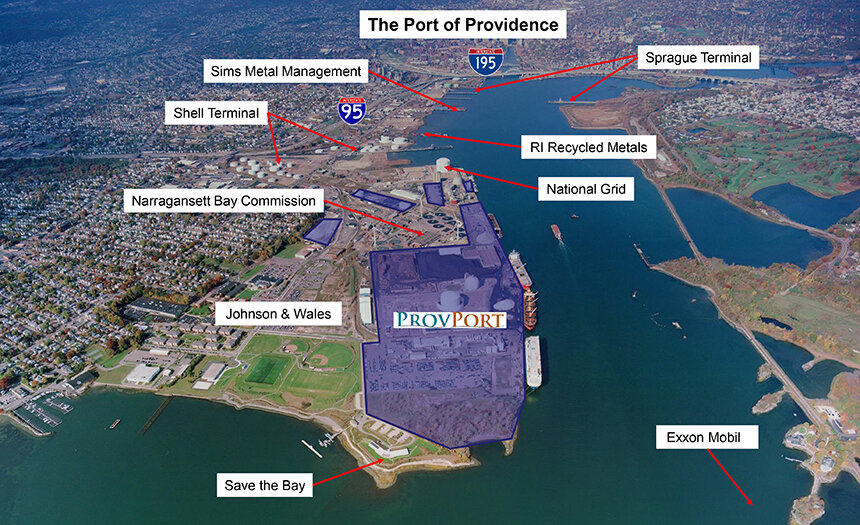Liquefied Petroleum Gas Deliveries Return to ProvPort
December 31, 2019
PROVIDENCE — The city’s port isn’t getting any safer or less polluted as industrial activities expand.
The latest development is the return of liquefied petroleum gas (LPG) deliveries to a marine shipping terminal at ProvPort. The 10-acre facility receives LPG from pressurized ships and converts the fuel to propane for home heating and backup power generation.
ProvPort, the city-affiliated nonprofit that manages portions of the industrial waterfront, said the service is nothing new. The LPG terminal with its prominent 16-million-gallon storage tank has been receiving LPG shipments since 1971. The previous fossil-fuel transport company, Teppco Partners LP, ceased operations in 2016. The new tenant, Sea-3 Providence LLC, a subsidiary of Texas-based Blackline Partners, signed a long-term lease to operate the terminal. The first delivery arrived in early November.
“The facility is strategic to the long-term success of ProvPort and to meet the area’s LPG demands reliably,” ProvPort spokesperson Bill Fischer said.
He noted that ProvPort will ensure that the terminal complies with all state and local regulations. An ordinance proposed by City Council member Pedro Espinal would require the presence of a full police detail when future LPG or liquefied natural gas (LNG) deliveries arrive at the port. The November LPG shipment arrived with a Coast Guard escort.
Although rare, LPG tanker accidents can be devastating. A two-tanker explosion in the Black Sea last January killed 14 crew members.

Local residents who live in the Port of Providence area are concerned about living near vast amounts of the highly flammable fuel, as well as the subsequent traffic and air pollution the resumed deliveries of LPG will inevitably create. When Teppco Partners was in operation, an estimated 80-100 trucks refueled at the terminal each day during winter, when demand was highest.
“It’s just a bad thing all the way around,” said Linda Perri, head of the Washington Park Neighborhood Association.
The group, concerned residents, and other organizations such the Providence Coalition of Neighborhood Associations (ProvCNA) are exasperated by noxious odors, increasing truck traffic in and around Allens Avenue, and related pollution from a number of new or expanding businesses. These activities include an LNG processor, expanded road-salt storage facilities, and construction at the Johnson & Wales University Harborside Campus.
A proposed construction-waste processing facility is expected to add another 188 daily truck deliveries. A 2018 gasoline spill on an on-ramp to Interstate 95 North and other accidents, along with dust and additional sources of air pollutants, are major concerns for a community that already suffers from high rates of asthma.
In a recent letter to the City Planning Commission, Perri asked the commission to delay a Jan. 21 public hearing for the proposed construction-waste processing facility’s master plan.
“We are on a campaign to stop this or postpone the hearing,” Perri said. “We haven’t had time to assimilate this (proposal).”
Perri and ProvCNA launched an online petition calling for the city to deny the permits and for new laws to reduce pollution at the port.
Allens Providence Recycling LLC (APR), the operator of the proposed facility, said the operation will revitalize a contaminated property. Christopher Koehler, a spokesperson for APR, said stormwater runoff, dust, and other pollutants will be contained “in the safest and most environmentally friendly manner possible.”
ProvPort’s LPG site is the second-largest in the Northeast and the only refrigerated, water-accessible propane storage terminal in southern New England. Blackline Partners also operates New England’s largest LPG terminal, in Newington, N.H.
The massive propane tank on Providence’s waterfront is surrounded by a 52-foot-tall containment wall and a 15-foot-tall berm. In an emergency or shutdown, propane is flared from a 90-foot stack.
Pollution at the port, however, will likely be worsened by the operating-again LPG terminal. Before the fuel is loaded on tanker trucks, it’s heated by two natural-gas and two propane boilers. Two 150-horsepower compressors maintain pressure and temperature control in the delivery and storage system.
Pubic approval isn’t needed for the propane facility because Sea-3 Providence is taking over existing permits.
“It’s a sad day when citizens are having this shoved down their throat,” Perri said.



